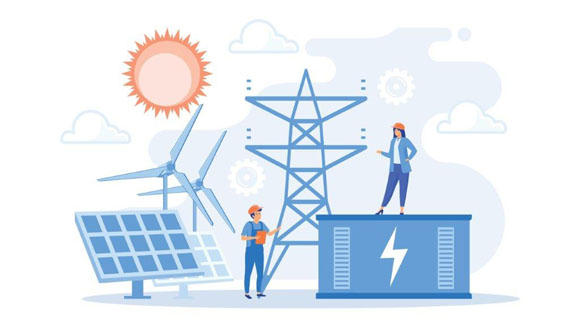Electricity storage is being increasingly important
The role of electricity storage facilities is becoming increasingly important. The new Electricity Storage Strategy defines fields of action and stipulates measures for the further expansion of electricity storage facilities and their optimal integration into the electricity system.
 © Adobe Stock / Alwie99d
© Adobe Stock / Alwie99d
Ready for a quick glimpse into the future? We’re heading for 2035. Germany’s electricity supply is now climate-neutral and nearly all of the energy used is renewable energy. Germany’s installed wind power amounts to 145 gigawatts, which comes on top of 215 gigawatts of photovoltaic power. There are growing fluctuations between amounts of electricity being fed into the grid and being consumed, not least because of new devices on the demand side, such as electric vehicles. After all, electricity from renewables is not always needed when it is generated.
Electricity system needs to become more flexible
As a result of this, our electricity system must become more flexible to balance out fluctuations between the demand side and the supply side. While grids can transport power to other regions, storage systems can allow for temporary delays in consumption. They are like time machines and becoming ever more important as the energy transition proceeds. Against this backdrop, the Electricity Storage Strategy published by the Federal Ministry for Economic Affairs and Climate Action in mid-December 2023 is the first to list all the measures required for a further ramp-up of electricity storage.
Who is storing what?
A dynamic expansion of electricity storage capacity is already in progress and the new Strategy is to provide fresh momentum for it. Taken together, the 18 measures listed in the paper are to deliver the desired outcomes.
Electricity storage facilities are categorised as large-scale storage facilities (pumped storage plants, large-scale battery storage) and small-scale storage facilities (commercial storage facilities, home storage units and back-charging electric vehicles). Pumped storage plants and battery storage (large-scale batteries and distributed home storage units) are currently the most important categories used for short-term electricity storage.
The small-scale storage units currently being installed are mostly used to allow for better use of self-generated electricity. In other words, they primarily use electricity from PV rooftop installations and take electricity from the grid only when necessary. Batteries of electric vehicles are also categorised as small-scale storage devices.
Individual measures are to work in combination with each other
The individual measures to be taken under the Electricity Storage Strategy include an analysis of the current obstacles slowing down the expansion of electricity storage capacity and an assessment of the role of electricity storage in the context of the Renewable Energy Sources Act, but also address issues like grid charges, financial contributions towards construction costs und grid connection, how to benefit the communities in which storage facilities are situated, how to ensure system stability and improve balancing power, an evaluation of grid boosters, how to harness the potential of bidirectional charging, a discussion on obstacles to the construction of the pumped storage plants, electricity storage as a flexibility option, the potential for electricity storage within the energy system, the development of statistics on storage, support for innovation and research, support for the production of battery cells and systems components, and a survey of industry.
For a number of FAQs regarding all measures taken under the Electricity Storage Strategy, please click here (in German only). Consultations about the Electricity Storage Strategy (in German only) ended in mid-January. The written statements made by industry associations are currently being assessed.
Further information
- Press release by the Federal Ministry for Economic Affairs and Climate Action: Federal Ministry for Economic Affairs and Climate Action presents Electricity Storage Strategy (in German only)
- FAQs about the Electricity Storage Strategy (in German only)
- Download from the Federal Ministry for Economic Affairs and Climate Action: Electricity Storage Strategy (PDF, 797 KB) (in German only)

